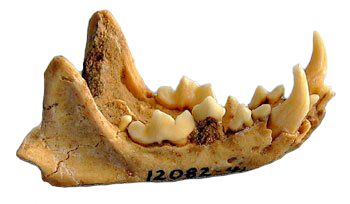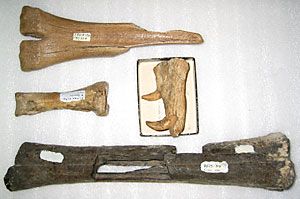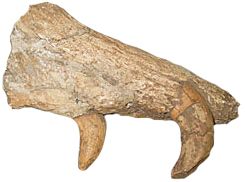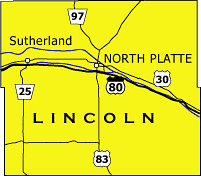
Nebraska County Fossils
Lincoln
< Vertebrate Paleontology Home
A virtual journey through the Museum's vertebrate paleontology collection.
Mustela nigripes, Black-footed Ferret
Family: Mustelidae
Geologic age: Late Pleistocene, about 17 thousand years old
Year fossil collected: 1941


Many of the mammals living in Nebraska 10-20,000 years ago were the same species as those living today. The black-footed ferret is now an endangered species and the last surviving natural population is found in Wyoming. This fossil ferret is from what is known as the "Citellus Zone", a layer of silt so named because of the abundance of the ground squirrel (Spermophilus richardsoni) that once bore that name. Ferrets feed predominantly on burrowing rodents, and with the decline of ground squirrels and prairie dogs in Nebraska, the black-footed ferret no longer lives in the state.
Mammuthus, Mammoth
Family: Elephantidae
Geologic age: Late Pleistocene, about 20 thousand years old
Year fossil collected: 1939


The most durable part of any mammal are its teeth, even when the mammal is as large as a mammoth. Even large bones and tusks deteriorate rapidly when exposed to weathering, but tooth enamel often remains when all other parts have turned to dust. The wind-blown silts of Lincoln County have produced a fair number of mammoth teeth over the years.
Camelops, Camel
Family: Camelidae
Geologic age: Pleistocene, about 17 thousand years old
Year fossil collected: 1930


Although these teeth look pretty formidable, they actually belong to a camel named Camelops. The specimen below is part of the snout (premaxilla) of a large male camel from the loess (wind-blown silt) deposits of Lincoln County. Several other Camelops bones are included in the collection from the county.
Geological Ages of Rock Formations

| Q | Pleistocene ("Ice Age") Sands, gravels, silts overlay much of the county (not shown) Pleistocene sands, gravels and silts overlay much of Nebraska and often conceal the bedrock beneath. These "Ice Age" deposits often produce the remains of mammoths, bison, horses, musk oxen, elk and other familiar mammals. Small fossils, especially, are important indicators of the climate at the time of deposition. |
| Tpo | Tertiary, Miocene/Pliocene, Ogallala Group, 2-14 million years old Ogallala Group rocks include predominantly clastic sands and sandstones composed of a mixture of Rocky Mountain debris and locally derived and re-worked sediments. Ash beds are not unusual in the Ogallala and help to precisely date the sediments. In western and southwestern Nebraska, the Ogallala beds are responsible for resistant bluffs that cap the valley sides of modern streams. Sandhills and loess (wind-blown silt) cover much of the county. Bedrock outcrops are rare or non-existant. |





